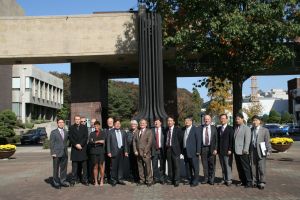Joint research of KIT and the Korean Institute of Science and Technology (KIST) focuses on the area of biological interfaces. Exchange of scientific know-how has taken place for more than 10 years. Now, the partners wish to extend it among others by establishing tandems of scientists, who jointly work on projects. Cooperation in other research areas is to follow rapidly. Representatives of both sides will prepare these cooperation projects at a meeting in Seoul this week.
“KIST was the first Korean institute to focus on the development and implementation of high technologies. In biology, it is in the top group worldwide. This makes it an interesting partner in Asia,” says Professor Volker Saile, Chief Science Officer at KIT and head of the delegation that visits KIST and other research centers and universities in Korea this week. “KIST was founded in the 1960s to further Korea – and it has succeeded.”
Cooperation in the field of biology is well-established: A memorandum of understanding was signed by Forschungszentrum Karlsruhe and KIST in 2003. KIT also maintains close relations to KIST Europe in Saarbrucken. “Our overlap in the area of biological interfaces is very large,” says Saile. Now, a cooperation contract is to be concluded for an even closer strategic cooperation. In summer, 20 scientists of KIT and KIST organized into groups of two persons each. These groups will jointly work on projects in the future. “For young researchers, it will be attractive to go to Seoul. There, the conditions are ideal, laboratories are well equipped,” emphasizes Professor Saile. In the long term, KIT and KIST plan to extend the cooperation to other areas, including robotics, water management, and materials sciences.
The history of KIST also is of interest to KIT. In the 1980s, KIST was a research institute and university at the same time. Meanwhile, both parts have become independent again. In Saile’s opinion, the merger failed, because it had been “enforced” by the state, whereas the KIT merger was based on the joint conviction of both partners.
The Daegu Gyeongbuk Institute of Science and Technology (DGIST) might soon become another Korean partner of KIT: It was founded as a research center in 2004 and is now establishing master and PhD programs as a university. It is planned to sign a memorandum of understanding in order to transfer the experience gained by KIT to Gyeongbuk.
In close partnership with society, KIT develops solutions for urgent challenges – from climate change, energy transition and sustainable use of natural resources to artificial intelligence, sovereignty and an aging population. As The University in the Helmholtz Association, KIT unites scientific excellence from insight to application-driven research under one roof – and is thus in a unique position to drive this transformation. As a University of Excellence, KIT offers its more than 10,000 employees and 22,800 students outstanding opportunities to shape a sustainable and resilient future. KIT – Science for Impact.

